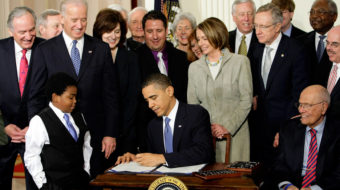
WASHINGTON – The head of the Pension Benefit Guaranty Corp., which insures traditional private pensions – and which steps in when a company tries to dump its pension plan – wants to change how his agency charges premiums to firms it serves.
In congressional testimony in early February, PBGC Director Joshua Gotbaum, an Obama appointee, proposed that the agency’s board be allowed to set the premiums it charges, case by case and company by company, based on risk and other factors. Essentially, he said, the federal agency should have the same leeway now granted to private insurance firms.
Gotbaum made big news last month when his agency slapped a lien on $90 million worth of property belonging to American Airlines, which has filed for bankruptcy. Pointing to the airline’s vast holdings overseas, he said that American’s plan to eliminate pensions and lay off workers were far too drastic, considering it had not proven bankruptcy was its only option. He said, essentially, that there were considerable funds that the airline could have used to support pension plans which were used instead for other purposes.
Unions backed his move against American Airlines because they believe the company is using the bankruptcy route to get out of contractual obligations to its workers.
American is demanding massive numbers of layoffs and wants to kill its pensions plans, they say, and his holding bankruptcy over the heads of union negotiators. The company has as much as said, they claim, that if unions don’t go along it will take its case to a bankruptcy judge in New York.
The American Transportation Union, a major union at American Airlines, has actually connected the dots between what the airline is doing and Republican presidential candidate George Romney.
ATU demonstrators have been following Romney around the country as he campaigns, pointing out that Romney’s Bain Capital has been hired by the airline to guide the company through what it sees as its union-busting bankruptcy procedure.
Gotbaum, in his testimony before Congress, said virtually every other type of private insurer – in auto, health care, and the like – sets premiums and that his agency, as a government insurer, should be allowed to do the same.
Gotbaum added that letting the board set the premiums would help close a potential future shortfall of $26 billion between the assets the agency now has ($81 billion) and potential obligations ($107 billion).
Raising PBGC premiums on everybody, Gotbaum said, is not the answer.
Gotbaum discussion of his agency’s funding and Obama administration proposals to close the future gap took place at a House Education and the Workforce subcommittee hearing Feb. 2. The panel took no action, but looked to the hearing to gather information on the nation’s pension system – or, as Gotbaum’s testimony showed, non-system.
“Once we do the math, it’s clear that retirement is going to cost more, not less,” as Americans now live longer after they retire, he told lawmakers. “Unfortunately, pensions haven’t kept up.
“About one-third of American workers have no access to employer-provided retirement benefits; about one-half actually have such benefits. Of those that do, the majority have only have a defined contribution (DC) plan, usually a 401(k). Many of these plans lost value during the recent economic downturn. The tens of millions of Americans that have defined benefit (DB) pension plans are better off, but employers have been turning away from such plans,” Gotbaum added.
Part of the problem, Gotbaum testified, is the premiums PBGC charges to firms, per worker, are set by Congress and they’re way too small to fully fund future liabilities or to discourage firms from unilaterally dumping traditional DB pensions.
Some takeover artists, he noted, have learned how to “game the system” by buying a firm’s assets for themselves from the company they previously controlled, but not its liabilities, including its pensions. That leaves PBGC (the government) to pick up the pieces.
Gotbaum said American Airlines was using Chapter 11 bankruptcy reorganization to unload its pension obligations. American filed for bankruptcy earlier this year. It wants to lay off 13,000 workers – most of them Transport Workers Union members – and eliminate its pension plan.
“American provided only the latest and most graphic example” of the results of low PBGC premiums, Gotbaum said. It “sought and received funding relief from Congress. Instead of funding their pensions, they set aside a cash pool of over $4 billion.
“Since their bankruptcy filing, they have made it clear that they would like to terminate their pension plans. Doing so would increase PBGC’s deficit by some $9 billion. For this insurance, American has paid a total over 37 years of about $260 million in premiums.
“What’s just as disturbing is that financially sound companies are asked to make up the difference. If Congress were to increase those premiums just to cover actions of other companies, it would make the situation worse. Think how hard it is to convince companies to keep their plans while you’re asking them to pay for the losses of others.”
Meanwhile, TWU President James Little said American, which Gotbaum cited, wants to fire 20 percent of its staff, dump the pensions, and outsource maintenance of its planes to depots in developing countries, as other airlines do. American is virtually the only U.S. airline where all maintenance is done in the U.S., and by TWU members.
“TWU members approach this crisis as a union with a demonstrated track record of finding business savvy ways to partner with our employer,” Little added. “Since 2003, we’ve given back over $600 million from our paychecks – about 30 percent of our pay and benefits – so we could keep American’s planes in the air. And we lead the U.S. aviation industry in joint in-sourcing projects, generating billions in corporate revenues for AMR,” American’s parent holding company, “while saving thousands of jobs.”
Then Little took aim at American’s pension dump.
“AMR wants to dump $10 billion in liabilities on the PBGC, which insures defined-benefit pensions for more than 75 million workers. The agency is funded by employer-paid premiums, but it’s already running a $26 billion deficit. Gotbaum says AMR has not proven it needs to kill its pension plans to successfully reorganize. Other airlines, like Northwest, have emerged from bankruptcy with pension plans intact,” Little said.
“After paying themselves huge bonuses for years, AMR executives filed for Chapter 11 with $4 billion in the bank and $13 billion in credit for buying new planes. Former CEO Gerald Arpey thought the decision was so wrong-headed that he immediately resigned.”
Photo: Airline pilots at a demonstration against American Airlines four years ago warned that cutbacks endangered passenger safety. Now the airline wants to get rid of pensions and lay off even more workers. D.J. Peters/AP Photos













Comments